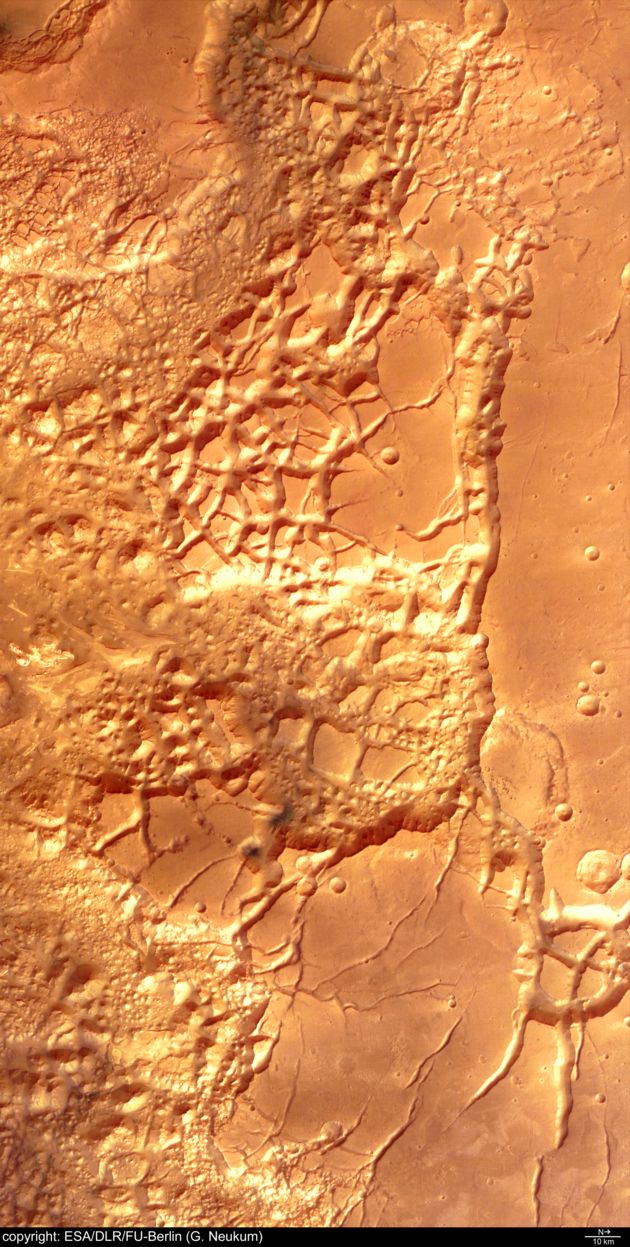Chaos on Mars

Terrain on Mars can be awfully chaotic. In fact one region is named precisely for the dizzying array of mounds and squiggles that follow no logic.
The Aureum Chaos region is dotted with large mesas and knobs that are distributed randomly, unlike the neat ranges of mountains often found on Earth. But scientists don't know why.
On Earth, mountain ranges are generally forged by the collisions between plates of the planet's crust. On Mars, there is less of this tectonic activity, and other forces are at work remaking the landscape. Much of the geologic activity on Mars took place long ago, and the planet appears to be less active today.
Aureum Chaos is in the eastern part of Valles Marineris, a huge scar on Mars much larger than the Grand Canyon. The mesas of Aureum Chaos range from a few miles wide to tens of miles.
New images from the European Space Agency's Mars Express orbiter reveal the terrain in detail.
In one image, a stark division occurs between the chaotic terrain, to the left, and a smoother plain to the right. A very bright area is starkly notable the middle of the image. Scientists think it is made of distinct layers created by the evaporation of fluids or by hydrothermal activity. Another image shows the same region from a perspective angle.
The history of Aureum Chaos is complex, the European scientists say. Perhaps the basin was filled with sediment long ago, after which the chaotic shaping took place. The extremely rough terrain might have been created by collapse of the surface when subsurface ice, magma or water somehow moved out of the region.
Get the Space.com Newsletter
Breaking space news, the latest updates on rocket launches, skywatching events and more!
By examining reflected light from the region, the scientists expect to learn more about the minerals that make up the various geological features.
Researchers are only just beginning to understand what sits beneath the surface of the red planet. Mars Express previously revealed strong evidence for huge blocks of ice near the equator. And in 2002, NASA's Mars Odyssey probe found strong signs of water ice lurking in vast quantities just beneath the surface of much of the planet.
Other recent studies suggest there may still be active volcanoes on Mars.
Scientists imagine an ancient Mars that was warmer and wetter, at least in spurts, and that some of the water seeped underground and is locked there today, mostly frozen. If that view is right, then there's a chance life once developed on Mars and could still thrive underground now.
- Strange Spots on Mars
- Sand Dunes on Mars Reach Dizzying Heights
- New Photos of 'Astounding' Mars
Join our Space Forums to keep talking space on the latest missions, night sky and more! And if you have a news tip, correction or comment, let us know at: community@space.com.

Rob has been producing internet content since the mid-1990s. He was a writer, editor and Director of Site Operations at Space.com starting in 1999. He served as Managing Editor of LiveScience since its launch in 2004. He then oversaw news operations for the Space.com's then-parent company TechMediaNetwork's growing suite of technology, science and business news sites. Prior to joining the company, Rob was an editor at The Star-Ledger in New Jersey. He has a journalism degree from Humboldt State University in California, is an author and also writes for Medium.









